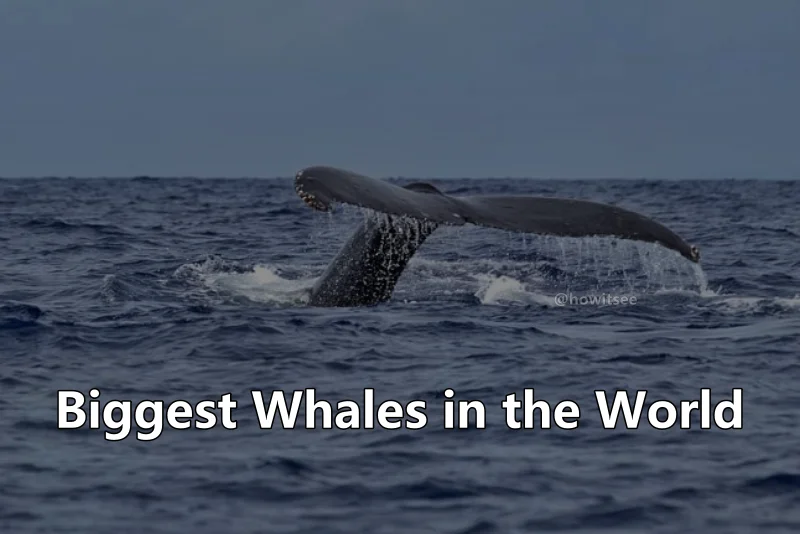Whales have always been a subject of wonder. Their enormous size, habits, and social behavior hint to us to a great extent about their intelligence. With so many gigantic species swimming in the blue, open waters, it often raises a question: Which are the largest whales? Therefore, in this article, we bring before you the Top 19 biggest whales in the world. Without much ado, let’s jump on to our article.
Top 19 Biggest Whales in the World Ranked
19) Dwarf Sperm Whale
| Scientific Name | Kogia sima |
| Size | 2 to 2.8 m |
| Life Span | up to 22 years |
| Location | Temperate and Tropical waters |
| Diet | squid and octopus |
Sperm Whales come in a wide spectrum of sizes, from one among the biggest whales to among the smallest. The Dwarf Sperm Whale inhabits tropical and temperate ocean waters, but preferably in warmer waters.
Their body size ranges between 2 to 2.8 m and their weight lies in the range of 140 to 270 kg (300 to 600 lb). The body is grey. The Dwarf Pygmy whales mainly feed on squids, crustaceans like crabs, and deepwater fishes.
18) Pygmy Sperm Whale
| Scientific Name | Kojia breviceps |
| Size | up to 4.2 m |
| Life Span | up to 23 years |
| Location | Temperate and Tropical waters |
| Diet | cephalopods, crustaceans & fish |
The Pygmy Sperm Whale is another relative to the Dwarf Sperm Whale. They belong to the class of toothed whales and can grow up to a length of 4.2m. They weigh anywhere between 450-500 kg (880-900 lb) and use a unique method to look for their prey, echolocation.
Cephalopods serve to be their primary diet, which includes squids, octopuses, etc. These whales, along with the Dwarf Sperm Whale, have a unique feature among Cetaceans; they use an ink-like substance as a defense mechanism, quite similar to squids and octopuses.
17) Beluga Whale
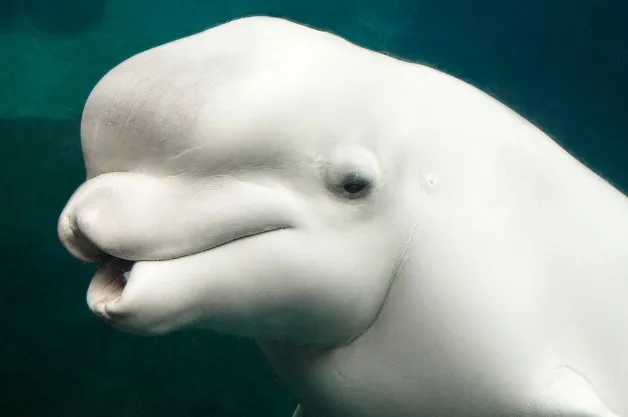
| Scientific Name | Delphinapterus leucas |
| Size | 3.5-5 m |
| Life Span | 35-50 years |
| Location | Arctic Ocean and nearby seas |
| Diet | octopus, squid, crabs, shrimp, clams, snails, and sandworms |
Next up on your list of the Biggest Whales on the planet, we have the friendliest gentle giant, the Beluga Whale. Known for their distinctive white coloration, Beluga whales are mostly found in the cold Arctic waters, where they are migratory.
They belong to the group of smaller-toothed whales and are highly social animals. Beluga whales use echolocation for hunting, navigating, and communication and are known to exhibit a wide spectrum of calls.
They can even imitate human speech to a certain extent and are among the most common Cetaceans to be kept in public aquariums. They grow up to a length of 3.5-5m (11-18ft) and weigh anywhere between 1100-1600 kg (2,430-3,500 lb).
16) Narwhal
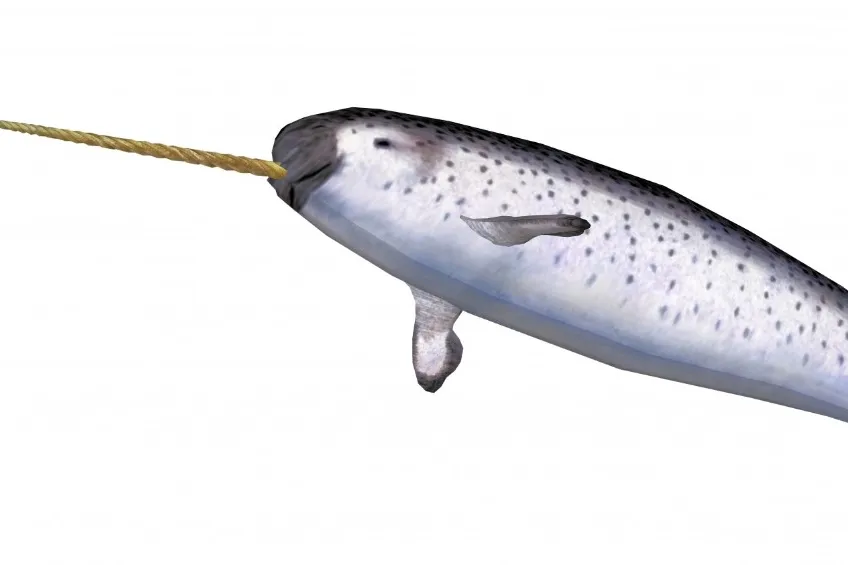
| Scientific Name | Monodon monoceros |
| Size | 3.95 to 5.5 m |
| Life Span | 35-50 years |
| Location | Arctic Ocean |
| Diet | octopus, squid, crabs, shrimp, clams, snails, and sandworms |
The closest relative to the Beluga Whales, Narwhals are known for their single long tusk, which serves to be their characteristic feature.
They are found in the colder waters of the Arctic and live in small groups, whose members can sometimes be as many as 20. Narwhals show seasonal migration.
These small whale species belong to the class of toothed whales, with its tusk (5-10 ft) being a modified canine tooth. Narwhals may grow up to a length of 5 ft and weigh anywhere between 800-1500 kg (1760-3500 lb).
Their diet is mainly Arctic-based, where they feed on Arctic halibut and cod, shrimps, squids, and other fishes found in the Arctic waters.
15) False Killer Whale

| Scientific Name | Pseudorca crassidens |
| Size | up to 6 m |
| Life Span | 58-63 years |
| Location | tropical, subtropical, and temperate waters of all ocean basins |
| Diet | fish and squid |
The next one on the list is False Killer Whales which can grow up to 20 ft and weigh up to 4,400 lb. Its name comes from having a skull similar to the killer whale and they are also one of the dangerous predators like them. Their body color is completely dark-grey.
14) Blainville’s Beaked Whale
| Scientific Name | Mesopladon densirostris |
| Size | up to 7 m |
| Life Span | up to 27 years |
| Location | Mid- Atlantic, Pacific Islands |
| Diet | squid and small fish |
The Beaked Whale derives its name from its distinctive feature, the moderately long beak-like structure. The Blainville’s Beaked whales are relatively smaller and grow up to a length of 7m (14.5 ft) and weigh anywhere between 800 kg (1800 lb).
These whales are found in tropical and warmer waters and forage primarily by suction feeding. Organisms like squids, small fish, and octopuses constitute their main diet.
13) Southern Minke Whale
| Scientific Name | Balaenoptera bonaerensis |
| Size | up to 9 m |
| Life Span | up to 50 years |
| Location | Antarctica |
| Diet | crustaceans, plankton, and small schooling fish |
Minke Whales are the smallest species of Rorquals, a group of whales that also houses the largest animal on earth, the Blue Whale. The Southern Minke Whale, a sub-species of the Minke Whale, is mostly found in the Southern Hemisphere of the planet.
They have an average body length of 9 m (30 ft) and can weigh up to 10 tons. They are exclusively euphausiid (krills) feeders and live and hunt in groups.
12) Orca
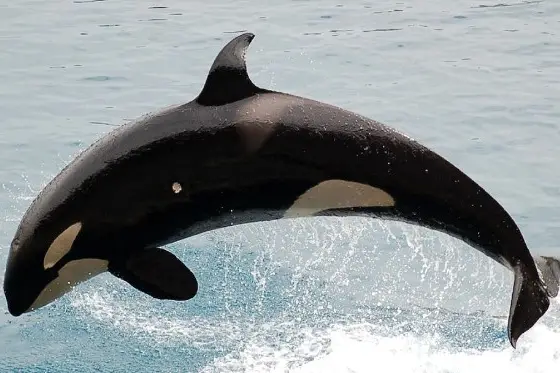
| Scientific Name | Orcinus orca |
| Size | 6-9.8 m |
| Life Span | 50 to 90 years |
| Location | North Atlantic, coasts of Argentina, South Africa, and New Zealand |
| Diet | schooling fish, minke whales, seals, stingrays, and sharks |
Killer Whales, or Orcas, occupy the 13th position on our list of Biggest Whales in the world. They belong to the family of toothed whales and have a wide distribution in the waters, from the Arctic to the Antarctic.
Orcas are highly social animals. They hunt in packs, much similar to wolves, and their prey mainly consists of seals, penguins, smaller whales, calves, fishes like Chinook, dolphins, rays, and smaller shark species.
Orcas are apex predators and have a very keen sense of hearing and smell. They use echolocation and exhibit a wide array of vocalizations. Orcas grow up to a length of 6-8 m, with females being slightly smaller and weighing up to 3-4 tons.
11) Northern Bottlenose whales
| Scientific Name | Hyperoodon ampullatus |
| Size | up to 10 m |
| Life Span | up to 37 years |
| Location | North Atlantic Ocean |
| Diet | fish and invertebrates |
The Northern Bottlenose Whales is a member of the Ziphiid family (beaked whales), known for their deep-sea habitat. They are known for their deep-sea dives and are one of the deepest diving mammals.
As the name suggests, these species occur in the North Atlantic Ocean and are deep-sea creatures known to live below 500m below the surface. Their deep-sea habitat has made their diet mostly of deep-sea squids and feeds on redfish, skates, and dogfish.
They reach a length of 9.8-10 m (32ft) and weigh between 5.8-7.5 tons (12,790- 16,530 lb).
10) Baird’s Beaked Whale & Arnoux’s Beaked Whale
| Scientific Name | Berardius arnuxii, Berardius bairdii |
| Size | 12-13 m |
| Life Span | up to 84 years |
| Location | Southern Hemisphere (Arnoux), North Pacific Ocean (Baird’s whale) |
| Diet | deepwater squid, crustaceans, and echinoderms |
These two species of Whales are two species of the same genera, one inhabiting the Northern waters while the latter inhabiting the Southern waters. These species reach an average length of 12- 13 m, with females being slightly larger than males.
In the toothed whale family, the Baird’s and the Arnoux’s Whales are the second-largest species, with only the sperm whale before them. These species of whales are deep-sea creatures that live in the depth of 2000-3000 m and mostly feed on deep-sea creatures.
9) Bryde’s Whales
| Scientific Name | Balaenoptera brydei |
| Size | 13-15 m |
| Life Span | 50 to 70 years |
| Location | in every ocean of the world |
| Diet | krill, copepods, red crabs, shrimp |
The Bryde’s Whale is not a single species but a constitution of 3-4 closely related species. The distinction has not been made due to the lack of research on these giant sea creatures.
These are moderately sized whales, with an average body length of 12 m, with certain species being slightly over 13 m, weighing approximately 15-25 tons. These species of whales are baleen whales, too, and are close relative to the Sei Whale.
They feed on a wide variety of fish, plankton, crustaceans, anchovy, etc.
8) Gray Whale
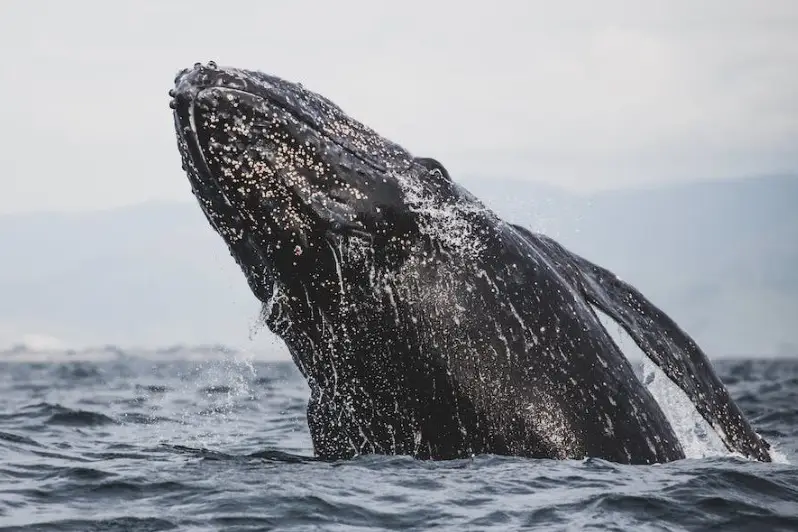
| Scientific Name | Eschrichtius robustus |
| Size | 13-15 m |
| Life Span | 50 to 60 years |
| Location | shallow coastal waters in the North Pacific Ocean |
| Diet | amphipod crustaceans |
In the 8th position in our list of Biggest whales in the world, we have the Gray Whale. They belong to the group of Baleen Whales that uses the mechanism of filter-feeding. They derive their name from the characteristic deep grey-white coloration.
These are large species of whales, with their average body length being 14-15 m (44-49 ft) and weighing approximately 36-40 tons. Their lack of dorsal fin is a characteristic feature of this species.
They feed on crustaceans, which house in the seabed. Feeding is done by scooping off sediments, where the organisms get trapped between their baleen (plate-like structures that act as sieves) while the sand is eliminated.
7) Right Whale
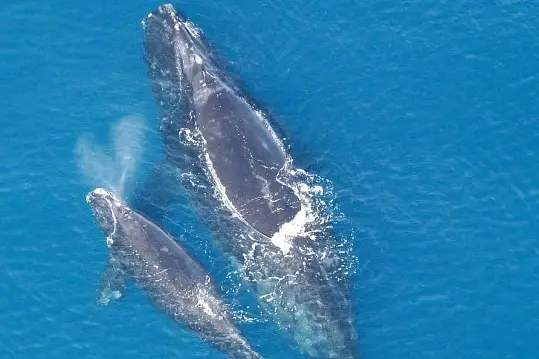
| Scientific Name | Eubalaena glacialis, Eubalaena japonica |
| Size | 13-16 m |
| Life Span | up to 70 years |
| Location | Atlantic coast of North America |
| Diet | copepods (tiny crustaceans) |
The 7th Biggest Whale in the world, the Right Whale is a collective of 3 large subspecies, the North Atlantic Right Whale, the North Pacific Right Whale, and the Southern Right Whale.
These whales have extremely thick bodies and can weigh as much as 100 tons. They have a general body length of 15-17 m, with the North Pacific species being the largest.
These whales are baleen too, and they feed mainly on copepods, krills, and other plankton. Their skin is characterized by large blotches, which are caused by parasitic whale lice and other crustaceans. These parasites attach themselves to the whale’s bodies and derive nutrition from them.
6) Humpback Whale
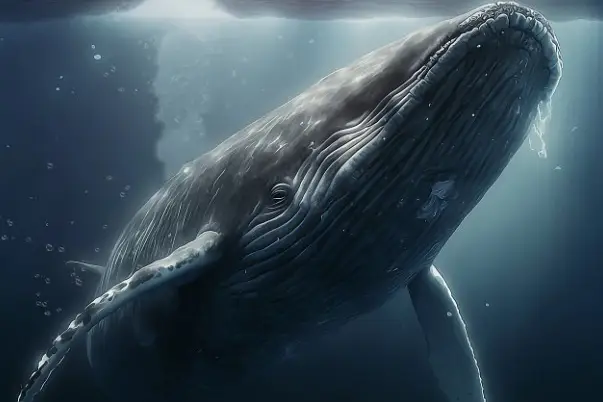
| Scientific Name | Megaptera novaeangliae |
| Size | 14-17 m |
| Life Span | 45 to 50 years |
| Location | North Pacific, Mid- Atlantic Ocean |
| Diet | small crustaceans (mostly krill) and small fish |
The Humpback Whale is one of the largest whales in the world, with a body length of nearly 17m and weighing approx 40 tons. Humpback whales can be distinguished from other species by their relatively larger pectoral fins.
They are migratory animals, are constantly on the move, and are said to travel approx 65,000 km annually. Humpback whales are baleen whales too, and they primarily feed on plankton, krill fish, and other small fishes.
They are popular for the frequent water breaching, which serves as major tourist attractions for whale watching.
5) Bowhead Whale
| Scientific Name | Balaena mysticetus |
| Size | 18-19 m |
| Life Span | 200 years |
| Location | Arctic Ocean |
| Diet | Marine invertebrates |
The only surviving species of the genus Balaena, The Bowhead whales, are found exclusively in the cold Arctic waters. Bowhead whales hold many records for themselves, like the largest mouth of any animal, and might also be the longest-living ones, as they can live up to 200 years of age.
These whales have large bodies with dark coloration. Bowhead whales derive their name from their triangular skull, whose primary function is to crack the thick ice layers.
Their body reaches up to a length of 19 m and shows sexual dimorphism, where females are larger than males. Their lacking of a dorsal fin is a characteristic feature.
4) Sei Whale
| Scientific Name | Balaenoptera borealis |
| Size | 16-20 m |
| Life Span | up to 60 years |
| Location | Atlantic, Indian, and Pacific Oceans |
| Diet | plankton, small schooling fish, and cephalopods |
The Sei Whale is the 4th Largest whale in the world and is baleen, i.e., they feed by a filter mechanism. They are found in most waters but avoid the Arctic and the hot tropical areas.
These Whales reach a length of 19 m and weigh nearly 30 tons. They mostly consume zooplankton, krill, and other smaller crustaceans, in huge numbers that weigh nearly 900 kg (200 lb). The Sei Whale is the fastest of all whale species and can swim at a speed of 50 mp/h.
3) Sperm Whale
| Scientific Name | Physeter macrocephalus |
| Size | 16-24 m |
| Life Span | 70 years |
| Location | All oceans |
| Diet | squid, sharks, skates, and fish |
In the 4th position on our list of Biggest Whales in the world, we have the Sperm Whale, the largest existing toothed whale.
Adult males grow up to a length of 24 m and weigh more than 50 tons, while females are quite shorter and weigh much less.
They have the largest brains of any animal on the planet. They feed on a wide range of species, which mostly include giant squids, octopuses, a large variety of fish, rays, and sharks.
You can spot these whales in the colder Arctic waters and sometimes even in the temperate and the tropical.
2) Fin Whale
| Scientific Name | Balaenoptera physalus |
| Size | 20-26 m |
| Life Span | up to 90 years |
| Location | Alaska, Mid-Atlantic, and Pacific islands |
| Diet | krill, small schooling fish, and squid |
Now, let’s talk about the second largest species of whale on the planet, the Fin Whale. Their wide distribution affects their sizes to some extent, where the Southern species were a bit longer than their Northern counterparts.
On average, they lie between 20-26 m and may weigh between 40- 50 tons. However, some recorded individuals have displayed lengths as much as 25 m. However, those are extremely rare cases.
They are also filter feeders, with their diet comprised of schooling fishes, copepods, small crustaceans, krill, herring, cods, salmons, etc.
1) Blue Whale
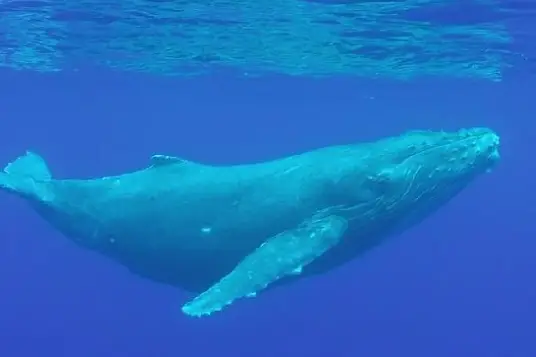
| Scientific Name | Balaenoptera musculus |
| Size | up to 30 m |
| Life Span | 80-90 years |
| Location | All oceans except the Arctic |
| Diet | krill, small fish |
Blue Whales are undoubtedly the biggest whales in the world. There are currently four subspecies spread across the oceans of the world. They grow up to an alarming length of 30 m or more and weigh approx. 200 tons.
They have long and slender bodies, with mostly grey coloration. Their dorsal fin region bears a unique pattern that helps to identify this species. These gigantic animals mostly feed on krills, where they take water into their mouth and flush it through the baleen plates.
Extensive whaling had driven them to the brink of extinction until its ban by the Whaling Commission.
Whales are now a highly endangered species. Indiscriminate whaling, tangling in discarded fishing nets, and collision against vessels serve to be the primary cause of the decline.
Though many countries have now framed various laws to protect these gentle giants, many countries like Japan, Canada, and Russia continue to hunt them.
Whale meat, fat, oils, skin, and bones serve to be primary objects of local consumption and export, especially to countries like China, where they are held for their medicinal value.
Whaling in the 19th and 20th centuries in numbers of hundreds and thousands has dwindled population to a few thousand. It’s high time to take suitable steps to conserve these apex predators, as they are highly essential to the marine ecosystem and, in turn to the world.
A complete ban on whaling can restore their population to normal but might take more than a millennium to do so.
Here, we conclude our article on “Largest Whales in the World.” We will be bringing many more such articles soon, so stay tuned and keep an eye on our website. Until then, goodbye.
Also Read:

Meet Monty, the visionary founder of How It See, being an engineering student, he’s fueled by an insatiable curiosity about the world around him. He is captivated by an eclectic correlation between animal groups, science, and nature, and this fascination drives his quest for understanding.
After completing his degree, he’s set on a mission to delve deep into the realm of nature, accumulating knowledge to share with you through his writing. In the meantime, he loves to watch anime and read anime.
